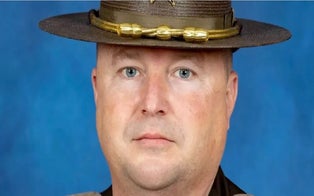When you send your kids off to college, you warn them about all sorts of dangers. However, have you ever thought to warn them about fire dangers where they live? Lisa Guerrero and the I-Squad investigated off-campus housing and found that many students
To show just how fast a fire can rip through a college room, the New York Office of Fire Prevention and the Center of Campus Fire Safety set up a demonstration and burned down a mock dorm room at the University at Albany.
Students looked on in awe as everything was destroyed in just minutes.
That's what happened when a discarded cigarette turned this off-campus house into an inferno last December at the University of St. Thomas in Minnesota.
Cameron Cochran and his girlfriend Katrina escaped the blaze by jumping out their second floor window. Here they are getting into an ambulance, but their roommate Michael Larson never made it out.
"It was just mind-boggling," said Cochran.
They say the only reason their alive today is because of Larson's screams which woke them up.
"It didn't make sense how he could warn me and not make it out," said Cochran.
Sadly, Larson's death is not an isolated incident.
In the past five years off-campus housing fires have claimed the lives of 40 students at colleges across the country but officials say almost every one of them could have been prevented.
Just two months ago at Indiana University, fire officials say a student actually disabled the smoke alarm in this off-campus apartment the very night before a blaze erupted. Dramatic calls flooded into 911:
Caller: "Oh my god, there's a fire, you need to come now!" said one student.
"Do you know if anybody else is still in the building?" the 911 operator asked another student.
"There's definitely people still in the building, so they need to get here fast! I almost died up there," exclaimed another student who barley escaped the blaze.
But 19-year-old Renee Ohrn never escaped. While the cause of the fire is still uncertain, fire officials reported the fire alarm in the building never went off.
We went back to the neighborhood where Renne Ohrn was killed. Students there allowed us to inspect their off-campus houses for fire hazards. With us was fire prevention expert Tim Knisely from Fire-Safe Solutions. He immediately noticed a glaring problem in the first home we inspected.
"The first thing I see is a smoke detector that's missing," said Knisely.
The students there say they actually took down one of their smoke detector because it kept annoying them with false alarms.
INSIDE EDITION's Lisa Guerrero asked, "Should they have a fire alarm somewhere down here?"
"They should put it back. You never know when a fire may happen," said Knisely.
Next, we checked the home of four coeds living nearby. At first glance everything looked good, but then Knisely spotted a problem hiding in the basement. The girls were using their furnace area for a storage closet --a big no, no.
"You don't want to have anything packed against this, especially anything that can burn like cardboard or paper," said Knisely.
Guerrero asked, "Does this signal to you that this is a potential fire hazard?"
"Oh sure it is. A good rule of thumb is three feet from anything that burns," said Knisely.
While some of the rooms had working smoke detectors, we found one sitting in a drawer. It was missing a battery and over ten years old.
Guerrero asked, "Why is your fire alarm in your drawer?"
"Because no matter how many times I changed the battery it just kept going off in the middle of the night," answered the college senior.
"That's not going to help you if there's a fire," said Guerrero.
"No it's not," she admitted.
But of all the off-campus houses we inspected, our expert says one run-down home was the biggest fire trap. Seven guys pay almost $40,000 a year to live in the house. We found smoke detectors missing or busted, light fixtures broken and exposed, tangled messes of overloaded electronics. And even a refrigerator shoved in a closet. All potential fire dangers.
Outside we discovered even more problems.
"This is bad," said Knisely.
Our expert wanted to go into the basement to inspect the home's furnace and wiring but the entranceway was completely blocked.
"It's just pure neglect," said Knisely.
"So if you have to give a grade, what would you give it?" asked Guerrero.
"This would be a failing grade," said Knisely.
Since our visit, one of the students living there said the landlord sent someone over to make repairs. And his landlord told INSIDE EDITION the home meets all of the city's code requirements.
Cameron and his girlfriend Katrina know from terrible experience how dangerous off-campus fires can be. Rubble and a set of steps are all that remains of the home where they're roommate lost his life. They say it's a constant reminder of the nightmare they survived and should be a warning to others.
"Obviously we didn't take it seriously enough. You got to be smart to prevent something this bad from happening," said Cochran.
The Center for Campus Fire Safety says parents should always inspect their kids's off-campus houses before they move in and make sure they hold their landlords accountable for any repairs.
For more information on how to better protect your student's off-campus house or to speak with fire prevention expert Tim Knisely, please visit fire-safesolutions.com.






